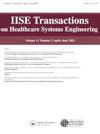滑动窗IMRT治疗计划的优化
IF 1.5
Q3 HEALTH CARE SCIENCES & SERVICES
IISE Transactions on Healthcare Systems Engineering
Pub Date : 2022-01-24
DOI:10.1080/24725579.2022.2027051
引用次数: 0
摘要
摘要具有滑动窗口的调强放射治疗(IMRT)是一种向肿瘤/靶区提供精确放射剂量的放射治疗形式。它使用多叶准直器(MLC)在辐射发射区域移动成对的单向钨叶,以使辐射束的形状与目标区域一致。这是一种动态治疗方法,旨在向目标区域输送足够的辐射剂量,同时最大限度地减少向健康组织的辐射输送。本文提出了一种具有滑动窗口的IMRT线性优化模型。该模型直接结合了许多产能限制,以符合LINAC的物理限制,包括处理过程中叶片之间所需的距离和对叶片叉指的限制。我们使用患者数据证明了该模型的可行性,并讨论了我们的模型提出的叶片运动。这样的模型可以嵌入治疗计划系统中,以提高治疗的质量和治疗计划过程的效率。本文章由计算机程序翻译,如有差异,请以英文原文为准。
Optimization of sliding windows IMRT treatment planning
Abstract Intensity-modulated radiation therapy (IMRT) with sliding windows is a form of radiation therapy that delivers precise radiation dose to a tumor/target region. It uses a multi-leaf collimator (MLC) to move pairs of unidirectional tungsten leaves across a radiation emitting region to conform the shape of the radiation beam to the target regions. This is a dynamic treatment approach which aims to deliver adequate radiation dose to target regions while minimizing radiation delivery to healthy tissues. This paper proposes a linear optimization model for IMRT with sliding windows. This model directly incorporates a number of deliverability constraints to conform to physical limitations of the LINAC, including the required distance between leaves through the treatment process and restrictions on leaf interdigitation. We demonstrate the viability of this model using patient data and discuss the leaf motion proposed by our model. Such a model can be embedded in treatment planning systems to improve both the quality of the treatment and the efficiency of the treatment planning process.
求助全文
通过发布文献求助,成功后即可免费获取论文全文。
去求助
来源期刊

IISE Transactions on Healthcare Systems Engineering
Social Sciences-Safety Research
CiteScore
3.10
自引率
0.00%
发文量
19
期刊介绍:
IISE Transactions on Healthcare Systems Engineering aims to foster the healthcare systems community by publishing high quality papers that have a strong methodological focus and direct applicability to healthcare systems. Published quarterly, the journal supports research that explores: · Healthcare Operations Management · Medical Decision Making · Socio-Technical Systems Analysis related to healthcare · Quality Engineering · Healthcare Informatics · Healthcare Policy We are looking forward to accepting submissions that document the development and use of industrial and systems engineering tools and techniques including: · Healthcare operations research · Healthcare statistics · Healthcare information systems · Healthcare work measurement · Human factors/ergonomics applied to healthcare systems Research that explores the integration of these tools and techniques with those from other engineering and medical disciplines are also featured. We encourage the submission of clinical notes, or practice notes, to show the impact of contributions that will be published. We also encourage authors to collect an impact statement from their clinical partners to show the impact of research in the clinical practices.
 求助内容:
求助内容: 应助结果提醒方式:
应助结果提醒方式:


